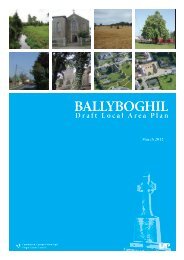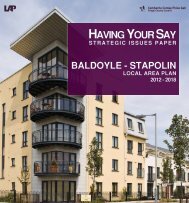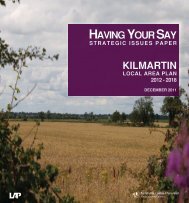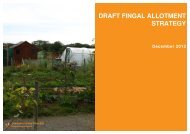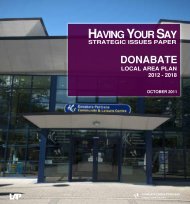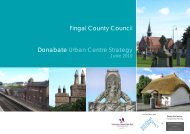Swords Masterplan - Fingal County Council
Swords Masterplan - Fingal County Council
Swords Masterplan - Fingal County Council
Create successful ePaper yourself
Turn your PDF publications into a flip-book with our unique Google optimized e-Paper software.
11.1 Sustainability and Transport<br />
The <strong>Council</strong> will seek to promote more sustainable forms of mixed use<br />
development within the town, to increase the use of public transport and<br />
encourage the use of walking and cycling modes for trips at local level. Any<br />
future LAP /s for <strong>Swords</strong> will address all mobility needs and put in place a<br />
strategy to promote the development and use of public transport, as well as<br />
walking and cycling so as to reduce car traffic demands within the town, and<br />
particularly within the Town Centre. The development of town bus services which<br />
are fully integrated with Metro North will maximise the benefits of and the<br />
efficient use of the Metro for the benefit of those living and working in <strong>Swords</strong>.<br />
11.2 Sustainability and<br />
Building Design<br />
Buildings have considerable environmental impact, for example through<br />
operational energy, transportation of people between them, raw materials<br />
consumed by the building and use of land. Building design will reflect national<br />
sustainability and energy conservation policies and contribute to the creation of<br />
appropriate urban form within the development.<br />
In their life cycle, energy is used in buildings in a number of different ways:<br />
● In construction<br />
● In operation, for lighting, heating and power<br />
● For demolition, recycling and disposal<br />
The importance of implementing more sustainable design in construction has<br />
been identified as a key part of supporting sustainable development overall.<br />
Increasing levels of building construction creates increased greenhouse gas<br />
emission which has in turn been linked to changes in climate and global<br />
warming. By far the biggest contribution to greenhouse gases is in emissions of<br />
carbon dioxide. The building sector is a major energy consumer, accounting for<br />
approximately 40% of total energy consumption, of which residential development<br />
accounts for 25% (SEI 2005).<br />
There are many examples of buildings and technologies that demonstrate the<br />
feasibility and viability of achieving substantial reductions in CO2 emissions form<br />
developments via good design, choice of construction method and location close<br />
to existing public transport interchanges.<br />
S W O R D S M A S T E R P L A N<br />
11.0 Sustainability Agenda<br />
<strong>Fingal</strong> <strong>County</strong> <strong>Council</strong> is committed as a priority to encouraging more sustainable<br />
development through energy-end-use-efficiency, and increasing the use of<br />
renewable energy in all new building projects in the designated area within<br />
<strong>Swords</strong> This will be achieved by improving the requirements as set out in Part L<br />
of the Building Regulations 2007 i.e.:<br />
All dwellings to achieve a minimum BER (Building Energy Rating) of A3, all non<br />
domestic buildings to achieve a minimum BER (Building Energy Rating) of B2.<br />
These targets will be reviewed and revised by <strong>Fingal</strong> <strong>County</strong> <strong>Council</strong> in 2010.<br />
It is an objective of <strong>Fingal</strong> <strong>County</strong> <strong>Council</strong> to promote sustainability as part of<br />
future developments within the <strong>Masterplan</strong> area and throughout <strong>Swords</strong>. The<br />
<strong>Council</strong> encourages superior energy design and technological practices in all<br />
developments. It is the policy of the <strong>Council</strong> to improve qualitative standards of<br />
sustainable design in proposed developments.<br />
1 0 7<br />
11.2.8 USE OF LOW ENERGY/<br />
CARBON REDUCING TECHNOLOGIES<br />
Once a development’s energy consumption has been minimised, carbon reducing<br />
technologies should be investigated to further reduce the demands for fossil fuel<br />
based energies and in turn reduce the buildings’ carbon emissions<br />
11.2.9 PROVIDING REQUIRED ENERGY<br />
IN MOST EFFICIENT WAY<br />
Efficiency measures and demand reduction will not reduce CO2 emissions to the<br />
required national and international targets. Once energy use has been minimised<br />
the energy required should be provided in the most efficient way. Alternative<br />
means of generating energy that produce far less CO2 need to be considered,<br />
such as local combined heat and power which is considerably more efficient than<br />
power supplied remotely with their attendant transmission and heat losses. The<br />
feasibility for local power generation on town scale, once the preserve of national<br />
utilities, is now both economically viable and well tested at an international level.<br />
Major European cities, such as Helsinki and London, and smaller towns are in<br />
the process of adopting this strategy as a cornerstone of their energy strategy.<br />
The proposed scale and mix of development in <strong>Swords</strong> Town Centre indicates<br />
that it would be appropriate to invest in a local power and heat generation<br />
infrastructure.<br />
The design of the building services presents opportunities for energy saving and<br />
reduced carbon emissions through the careful selection of plant, controls and<br />
management of the services.<br />
Non fossil fuels such as biomass of woodchips offers an alternative which is in<br />
effect carbon neutral but supply is currently too limited and is unlikely to be able<br />
to scaled up to supply power and large town scale.<br />
Buildings can generate their own power via building mounted solar or wind<br />
energy collectors, but due to limited available surface area this can only supply<br />
typically fewer than 20% of the required power.<br />
The following measures should be considered to increase the efficiency of<br />
buildings within a development:<br />
● Heat Recovery: Incorporation of heat recovery into ventilation systems to<br />
allow the reclaim of energy.<br />
● Free cooling: Plant and equipment optimised for use of free cooling for air<br />
and water systems when suitable external conditions exist.<br />
● Lighting: The lighting in the development will incorporate low energy lamps<br />
with lighting controls incorporating daylight saving.<br />
● Variable speed pumping and fans: The air and water systems will be<br />
designed using variable speed drives.




